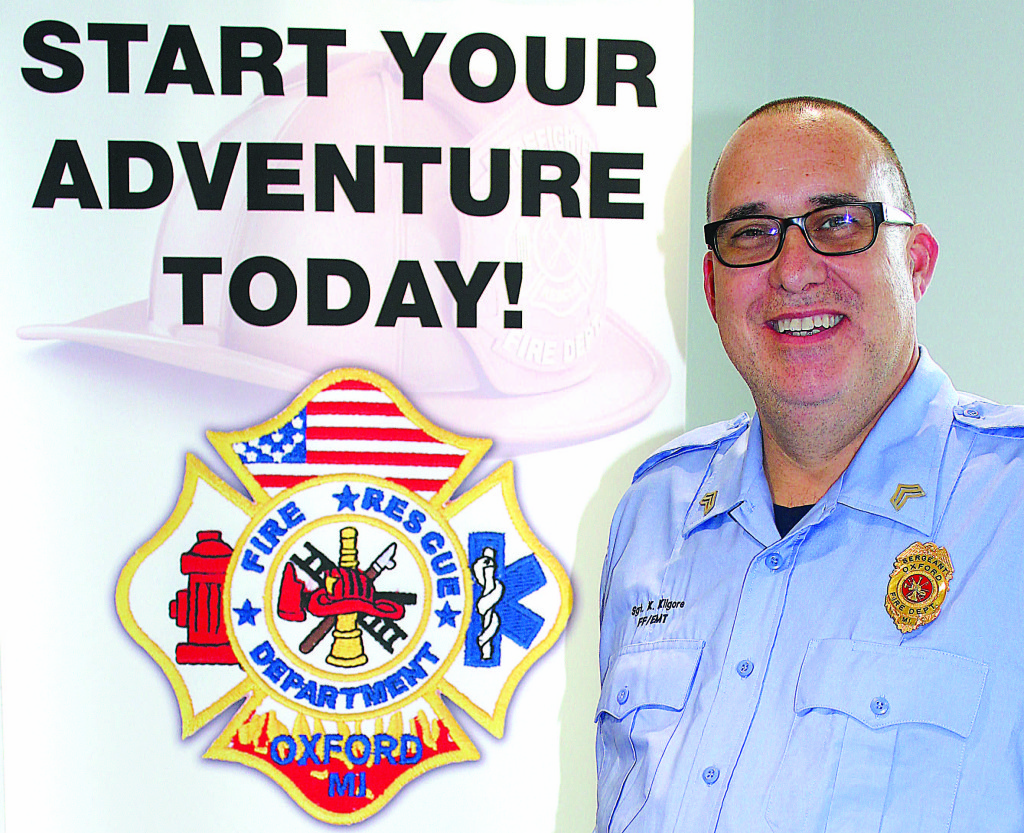
Kelly Kilgore is looking for a few good men and women to save lives and protect property by joining the Oxford Fire Department.
The 50-year-old Oxford resident was recently hired as the department’s recruitment/retention program manager, a new full-time position that’s being primarily funded by a $333,706 grant from the Federal Emergency Management Agency (FEMA). His four-year contract takes effect Oct. 31.
Kilgore’s starting salary will be $53,000, plus benefits, in the first year. After that, it will increase by 2.5 percent annually until it tops out at $57,075 in the fourth and final year.
His primary mission is to recruit and retain paid-on-call members for the department.
“I just think it’s a great way to give back to your community,” he said.
Fire Chief Pete Scholz said Kilgore was hired because he’s “very knowledgable, very compassionate” and he enjoys being a “mentor” to the department’s younger members.
Scholz was impressed by how Kilgore understands and relates to the needs and concerns of the younger members. “That’s something you’ve got to have a passion for,” he said.
Although the department is staffed by 16 full-time employees (including the chief and assistant chief), it still relies heavily on paid-on-call members to help handle everything from structure fires to vehicle crashes to emergency medical situations.
Currently, the department has 24 paid-on-call members – 20 firefighters/Emergency Medical Technicians (EMT) and four EMTs.
Unfortunately, Oxford, like many other fire departments in the area, has experienced a decline in paid-on-call staff over the years and is struggling to gain new recruits.
That’s where Kilgore comes in.
He knows firsthand what it means to be a paid-on-call firefighter/EMT because he’s been one since September 2005. He now holds the rank of sergeant.
It was an advertisement in the Oxford Leader, along with some prodding from his wife at the time, that convinced Kilgore to look into the world of hoses, helmets and big red trucks.
“I never had the desire to be a firefighter when I was a kid,” he explained, but after visiting the department and learning more about the job, “I was hooked.”
He’s never regretted that decision. He loves how supportive the community is of its fire department and how citizens never fail to express their gratitude to him and his fellow firefighters.
“It’s actually the people of Oxford that keep me going,” Kilgore said. “The thanks that we get is humbling. It’s just rewarding when the people of your town really stand behind you like that.”
Kilgore wants folks to know that being a paid-on-call firefigher/EMT isn’t just for adults in their 20s.
He joined the department when he was 38 years old.
“I started late in life,” said Kilgore, and since then, it’s become “a passion” for him.
People in their 30s, 40s and 50s are welcome to apply. “Age is really not that big of a deal as long as you can physically do the job,” Kilgore explained.
To become either a paid-on-call firefighter/EMT or paid-on-call EMT, applicants must successfully complete a physical agility test.
After that, they must attend a fire academy and/or EMT academy. The fire academy runs from January to June and the EMT academy from August to December. Students attend sessions on two weekday evenings (Monday and Thursday), plus one to two Saturdays per month.
“We don’t charge anybody to go to these academies,” Kilgore noted. “They don’t pay a thing. All they have to do is give us their time.”
Following graduation, there’s a probationary period where new recruits learn things specific to working for the Oxford Fire Department. How long this period lasts depends entirely on how quickly a recruit learns the ropes.
“We just had a guy who got off probation in under two months,” Kilgore said.
New recruits have up to two years to complete their probation.
Once an individual becomes a paid-on-call member, Kilgore said they’re expected to work a minimum of 18 hours, including training, per month, plus sign up for three squad shifts per month, where they must be available to respond to calls from 9 p.m. and 4 a.m.
Paid-on-call pay rates range from $10.23 to $19.18 per hour, depending on the programs completed and experience levels.
Kilgore believes there’s something very human about wanting to reach out and lend a hand to others “at their worst times,” when they’re hurt, sick or their house is on fire.
“I believe it’s in our nature to want to help people,” he said.
Even though “the outcome isn’t always good,” Kilgore said there are many more positive stories than tragic ones in firefighting.
During his 12 years with the department, Kilgore was directly involved in two instances where administering CPR was able to save lives.
“It showed me our job isn’t always doom and gloom,” he said. “Those two times have really kept me going.”
Of the $333,706 FEMA grant, $201,490 is for Kilgore’s salary and $121,480 is to cover his fringe benefits. The remainder of the grant will be spent on physicals for new recruits ($6,000) and textbooks for them ($4,736).
Over the next four years, Kilgore’s position is expected to cost a total of $369,641, which means $35,935 will come from the fire department’s budget.

Leave a Reply